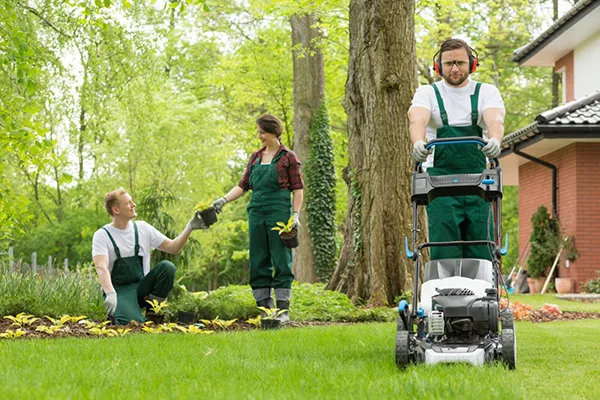KEY TAKEAWAY
- Spring lawn care focuses on cleaning, aerating, and fertilizing for growth.
- Water lawns early and mow high to protect grass during summer heat.
- Fall is ideal for leaf removal, fertilizing, aeration, and overseeding.
- Winter care includes debris removal and applying winterizing fertilizer.
- Year-round lawn health requires watering, pest control, and soil testing.

Let’s be honest, we all want to take care of our lawns. I mean, they enhance the overall look of your house, and a well-maintained lawn helps you wake up to beautiful scenery every single day. Not to mention, over 79% of Americans have said the lawn is an important part of a house.
However, people are often unable to take care of their lawns. It’s not that they are not trying to maintain it, but they are not doing it the right way. As the season changes, your lawn needs to be taken care of differently.
So, today in this article, I’ll mention understanding seasonal lawn care and what homeowners need to know. Let’s get started.
Spring: Wake Up Your Lawn
The spring season involves the warm weather we ache for and grass waking from its winter dormancy to grow actively. Spring is one of the most important seasons for foundational lawn care. Start by raking/removing debris, followed by dethatching the lawn to allow fresh air and sunlight to reach the soil.
Aerating your lawn encourages roots to grow deeper, while applying a slow-release fertilizer allows the grass to receive nutrients steadily rather than at once and will not overpower any initial growth.
There is also the option to apply a pre-emergent herbicide to prevent weeds from even sprouting in your lawn. Your lawn will flourish in the spring and remain resilient throughout the warmer months by mowing regularly and caring for it early in the season.
Summer: Keep It Cool and Green
In the summer, when keeping your lawn cool and green, you will want to devise smart seasonal strategies. Watering your yard in the morning also minimizes evaporation, while mowing it higher will help to protect the roots from intense sunshine. Clippings that are left to mulch can help retain nutrients and moisture in the soil.
During heat waves, avoid full fertilization as it can put stress on the grass. If you want hassle-free advice on keeping your yard healthy during the hottest months, check out myeaglelawns.com. You will find customized solutions that actually work for summer lawn care. Below you can see other things that you can do during summer.

Fall: Get Ready for Rest
Fall is the best time to prep your lawn for the colder months ahead. As the days get colder and growth slows down, January is typically a time for clean-up and giving nutrients. Raking the fallen leaves prevents mold while allowing sunlight to reach the grass.
A slow-release fertilizer helps to build root strength to make it through the winter months. This is also a great time to aerate your grass if the soil is compacted, as well as overseeding any patches. Following these steps will help ensure your lawn stays healthy and is stronger next spring.
Winter: Protect and Prepare
Winter is the season to protect your lawn from the harsh elements and prepare it for healthy regrowth. A few things you can do to protect your lawn are to remove debris and to apply winterizing fertilizer, which will support root health and resilience, preferably before the first frost.
Heavy foot traffic on frozen grass will severely damage it for the entire winter season, so try to stay off as much as possible. If you are in a snowy region, mark your paths to avoid compacting the lawn and stressing the turf.
Grass growth may be relatively non-existent during the winter; however, our care during the winter will help jump-start healthy, vibrant growth in the early spring.
Year-Round Tips for a Healthy Lawn
Taking care of your grass will almost tell a yard to come in. Keeping the lawn healthy, watering it properly, getting rid of weeds, checking for pests/diseases on the grass, and testing the soil every year for N, P, and K differences will help take care of your lawn.
The seasonal fertilizer application, along with keeping every tool clean, will help in pushing away diseases and keeping a good, productive lawn. It is amazing how basic lawn care can be; real lawn care runs from January to December without stopping.
PRO TIPSharpen your mower blades regularly to ensure clean cuts and healthier grass!
Start Planning Your Seasonal Lawn Care Today
Seasonal maintenance is the key to a healthy and beautiful lawn, so it’s useful to plan and think ahead. Each season is unique. In the spring, seeding and fertilizer are important; in the fall, cleanup and protection are required.
Your lawn care calendar can help you stay on top of your seasonal lawn requirements in a systematic way to reduce the rush at the end. Seasonal maintenance will be influenced by local climate, the type of grass in your lawn, and the soil conditions.
Plan ahead, and you can put your lawn exactly what it needs when it requires it. If you plan and follow an annual maintenance plan for your lawn, you’ll have a good green lawn all year round. Think ahead and implement a seasonal lawn care plan to achieve a great lawn.
Why does lawn care have to change along with the seasons?
Each season impacts grass differently, so we should take care of the grass in a way that helps support growth and health through the various weather conditions we have each season, and that provides resilience year-round.
When is the best time to fertilize a lawn?
Spring and fall are the best times to fertilize a lawn, helping to build roots in the spring and support active growth, and in the fall, prepare for winter dormancy.
How can I care for my lawn in winter?
To care for your lawn the best you can during winter: keep it clean of debris, apply winter fertilizer, and try not to walk on frozen grass. This allows you to reduce damage to the grass and help with a healthy spring regrowth.





